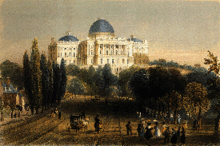Twenty-third Congress
| 23rd United States Congress | |
|---|---|
|
22nd ←
→ 24th
|
|

United States Capitol (1827)
|
|
| March 4, 1833 – March 4, 1835 | |
| Senate President | Martin Van Buren (J) |
| Senate Pres. pro tem: |
Hugh L. White (AJ) George Poindexter (J) John Tyler (J) |
| House Speaker: |
Andrew Stevenson (J) John Bell (J) |
| Members: | 48 Senators 240 Representatives 3 Non-voting members |
| Senate Majority: | Anti-Jacksonian |
| House Majority: | Jacksonian |
| Sessions | |
|
1st: December 2, 1833 – June 30, 1834 2nd: December 1, 1834 – March 4, 1835 |
|
The Twenty-third United States Congress was a meeting of the legislative branch of the United States federal government, consisting of the United States Senate and the United States House of Representatives. It met in Washington, D.C. from March 4, 1833 to March 4, 1835, during the fifth and sixth years of Andrew Jackson's presidency. The apportionment of seats in the House of Representatives was based on the Fifth Census of the United States in 1830. The Senate had an Anti-Jacksonian or National Republican majority, and the House had a Jacksonian or Democratic majority.
[Data unknown/missing. You can help!]
The count below identifies party affiliations at the beginning of the first session of this congress. Changes resulting from subsequent replacements are shown below in the "Changes in membership" section.
For the beginning of this congress, the size of the House was increased from 213 seats to 240 seats, following the 1830 United States Census (See 4 Stat. 516).
This list is arranged by chamber, then by state. Senators are listed in order of seniority, and Representatives are listed by district.
Senators were elected by the state legislatures every two years, with one-third beginning new six-year terms with each Congress. Preceding the names in the list below are Senate class numbers, which indicate the cycle of their election. In this Congress, Class 1 meant their term began with this Congress, requiring reelection in 1838; Class 2 meant their term ended with this Congress, requiring reelection in 1834; and Class 3 meant their term began in the last Congress, requiring reelection in 1836.
...
Wikipedia
